
This is a re-post from Yale Climate Connections by Karin Kirk
The rising cost of gasoline and diesel is both a frequent headline and an ongoing financial drain for many, let alone a major issue in the upcoming November midterm elections. But unlike previous gas crunches, some consumers now have options about the energy source that powers their driving.
Not long ago, electric vehicles were the domain of early-adopters and wealthy consumers, but times are changing fast. Moderately priced EVs range from $ 27,400 to $ 34,000, and as gasoline prices climb, EVs can offer respite from rising fuel costs.
As of June 1, 2022, the U.S. average price of regular gasoline was $ 4.67, according to AAA, and gas prices have climbed 41% percent since the start of this calendar year. Experts are saying those prices will continue increasing in days and weeks ahead The cost of electricity, meanwhile, has remained fairly stable – and relatively inexpensive compared with gasoline and diesel fuels. The U.S. average price for residential electricity is 13 cents per kilowatt hour. How does the cost of driving an EV compare to driving a gasoline-powered car?
The short answer is that it costs only $ 1.41 per “gallon” to drive an EV. That’s a 70% discount compared with gasoline.
The EV-to-gasoline cost comparison varies state-to-state, because the prices of electricity and gasoline differ in each state. The table below lists the breakdown of costs, by state.

Comparing prices between two fuels
These comparisons were made by calculating a “gallon-equivalent” for electric vehicles. This number is based on three factors: The average kWh per mile used by EVs, the average miles per gallon used by traditional vehicles, and the price of electricity. Multiplying these three numbers together yields the cost of charging an EV by an amount equivalent to one gallon of gasoline. The Department of Energy calls this number the “eGallon,” and, for those interested, walks through the math.
Price stability vs. volatility
Electricity prices tend to be stable over time, because rates are regulated by each state’s public utilities commission. By contrast, the price of oil fluctuates rapidly, driven by global pricing, geopolitics, refining capacity, and other market forces. As a result, drivers are subjected to largely uncontrollable swings in the cost of gasoline and diesel.
Case in point, the price of residential electricity went up by 3.6% over the past year, while gasoline has soared by 52% from a year ago – more than a tenfold difference.
From North Dakota to Hawaii: The highs and lows of different states
North Dakota has the cheapest electricity in the nation, so driving an EV works out to be equivalent to just 98 cents per gallon. That’s a savings of $ 3.33 per gallon, compared with gasoline.
The biggest savings for EVs is in Washington, where electricity is relatively cheap (and clean), but gasoline is expensive. Driving an EV in Washington saves $ 4.23 per gallon, an 81% discount compared with driving a gasoline-powered vehicle.
California has expensive electricity and also expensive gasoline. Fueling an electric car in California costs the equivalent of $ 2.60 per gallon, but gasoline costs more than $ 6 per gallon. The net result is that EV drivers in the Golden State see a savings of $ 3.59 per gallon.
The state with the smallest price differential for EVs is Hawaii, which has far and away the most expensive electricity in the country. Nevertheless, drivers in Hawaii still save $ 1.56 per gallon by switching to electric.
Prices subject to change
Clearly, making these comparisons using high gas prices will reflect a big savings for EVs. But you’d have to go back to 2002 to find a time when the price of gasoline was consistently below the $ 1.41 per gallon price of driving an EV.
In some locations electricity prices vary throughout a single day. Customers who charge their cars at night can save substantial money compared with the typical retail price, making EVs even cheaper to operate.
Going green, while saving green
For most people looking to stretch their budgets, rushing out to buy a new car isn’t necessarily a practical solution to a pressing economic concern, particularly with interest rates for car loans rising substantially. But gone are the days when EVs were expensive endeavors. A new 2022 Nissan Leaf, for example, sells for about $ 27,400 and costs the equivalent of $ 1.23 per gallon to drive. The deal is even sweeter because the Leaf qualifies for a $ 7,500 federal tax credit, which is available for EVs built by companies that have not yet sold 200,000 electric cars. Some states also offer incentives, but there’s no guarantee these programs will continue. After navigating tax credits and other fine print, an increasingly strong economic argument prompts some to consider making the switch to electric.
There are, of course, plenty of other factors to consider in the transition from internal combustion engines to electric ones. Range, charging options, and battery life are all important to consider. But in day-to-day operations, the inexpensive and stable price tag of driving with electrons rather than hydrocarbons offers an appealing alternative. Perhaps “thinking green” can be a motive for lower pollution and lower operating cost, all at once.
Data sources
To crunch the numbers for the table above, I used the 10 best-selling EVs and 10 best-selling internal combustion passenger cars in the U.S. in 2021. To make an apples-to-apples comparison on vehicle sizes, I used fuel economy data for cars only, not light trucks or SUVs. Energy use for both types of vehicles is from FuelEconomy.gov.
Electricity prices are from the Energy Information Administration, with most recent data from February 2022.
Weekly gas prices can be found from EIA and AAA.
U.S. News has a helpful explainer on EV tax credits.